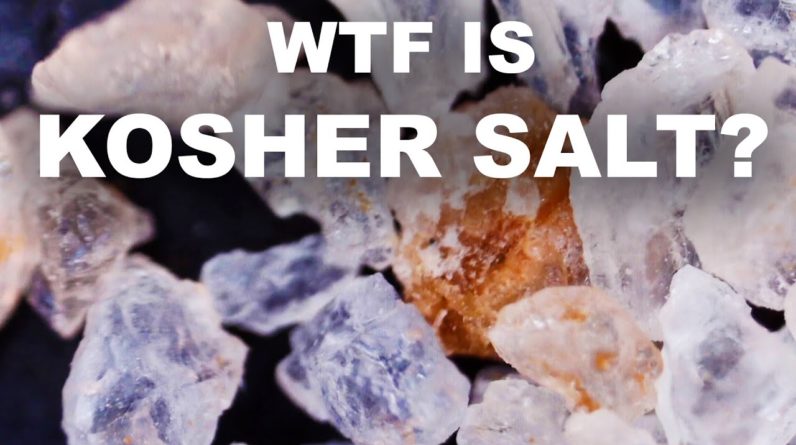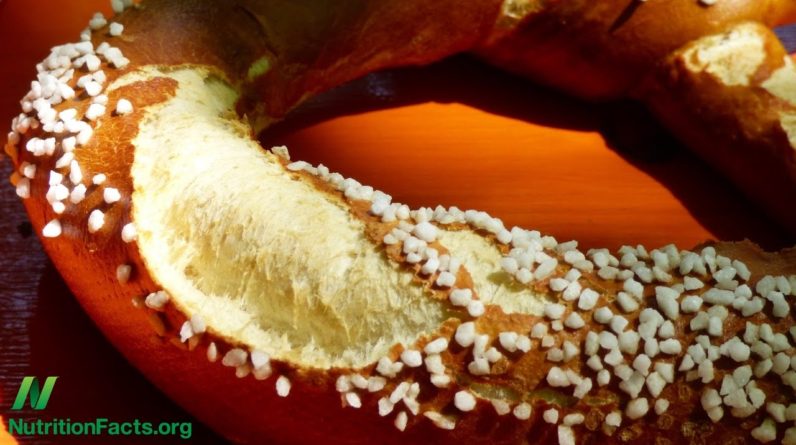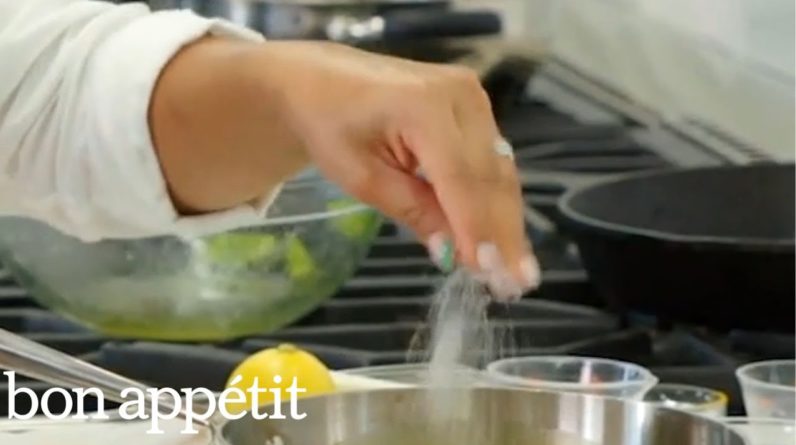
Hey, what even is kosher salt? And why do professional cooks favor it so heavily, at least American professional cooks? In much of the rest of the world, y'all have barely even heard of this stuff. My fellow Americans, go to a U.K. grocery chain's website and look for kosher salt. Waitrose has a million kinds of salt, no kosher salt — or at least nothing labeled as kosher salt. That's an important distinction because kosher salt is really just a name. It's a name for a very broad category of salts — coarse, flaky crystals of sodium chloride. Look at these salts under the microscope. This one is marketed as kosher salt, this one is marketed as kosher salt, and this one is kosher salt plus clearly a lot of other trace minerals.
These salts have nothing in common, except that they're all big and flaky and sold as kosher salt. To understand how we came to refer to something like this as kosher salt, we must first understand this country's special relationship with two isms: industrialism and Judaism. People of Jewish faith and/or heritage account for only about 4% of the U.S. population, yet more Jews live in the United States than in the whole rest of the world combined, minus Israel. It's been that way since World War II and the Holocaust.
Kosher is the English and Yiddish variant of the Hebrew word kasher, meaning correct or appropriate or fit. In the case of food, fit for consumption. If food is kosher, that means it complies with Kashrut, the somewhat elaborate body of Jewish dietary laws. The minutia of Kashrut is debatable and debated among Jews, but one highly cited authority is the Orthodox Union, a kosher certification agency in New York. OU says this Morton table salt is not kosher for a few reasons, one being it contains iodine. Iodine is a chemical additive that a century ago helped to eradicate the epidemic of goiter that happened all across the far northern United States. I have a whole episode about that in the description. Orthodox Union considers Morton Kosher to be kosher, but here's the thing — the kosher in kosher salt doesn't really refer to the salt itself being kosher, though it may also be kosher. The real reason a salt like this is called kosher salt is that big flaky salts are what you use for koshering meat — rendering meat fit for consumption under Jewish dietary laws. Big flaky salts are used for that, which is why we call them kosher salts.
They're more accurately called koshering salts or kashering salts. Lots of verses in the Torah forbid the eating of blood, and so lots of rules around the consumption of animals are geared toward minimizing residual blood that's left in the meat. This is probably one of the historical origins of meat slaughtering practices in both Judaism and in Islam — practices that are geared toward minimizing the emotional stress on the animal. When animals are really freaked out right before slaughter, their blood doesn't drain as thoroughly. The modern meat industry refers to this as fiery carcass. A properly slaughtered animal will have hardly any blood left in it after it's been drained. Blood just falls out of an open circulatory system. The heavy salting of meats called for in Jewish dietary law is intended to draw out any remaining residual blood, or perhaps things that people mistake for blood. Like, as I open up these lamb chops, that ain't blood.
That is myoglobin. That's the pink protein-laden liquid found inside all muscle tissue. When meat is juicy, that's the juice. Myoglobin is very similar to hemoglobin, which is the stuff that makes blood red. But they're still just not the same thing, and if you have a problem with eating myoglobin, then you have a problem with eating meat, because all meat is literally full of myoglobin.
That is the juice. You may still see a bit of actual blood inside major vessels. Kosher butchers will cut those out. The blood we see here is coming from the cut bones. Red blood cells — those are made in the marrow. Anyway, according to this set of procedures that I'm following from chabad.org, first we wash the meat thoroughly by hand. Then we soak the meat in clean, room-temperature water for at least half an hour and no more than a day. Then we wash it again and dry it. Now, we thoroughly coat the meat in salt and let it sit for at least one hour and no more than 12 hours.
It is commonly believed that big flakes of salt will stick better to the meat and dissolve at the rate optimal for drawing out the "blood." I've actually got six lamb chops on this board. After washing and drying, I will weigh them them all. Then these two, I will kosher with kosher salt. These two, I will kosher with table salt. These two, I won't salt at all. The salt draws water out of the meat by osmosis.
You can see that happening right there. Interestingly, early on, there's more stuff pooling around the chops that I coated in table salt, perhaps because the smaller grains dissolved more quickly. So, Is that blood? Well, it's water, plus maybe some other little molecules, other micro substances small enough to pass through the semi-permeable membranes of those meat cells. I suppose that maybe a little bit of that is coming from tiny little pockets of blood that are still residually in there? The interesting thing is, the minimal hour that koshering demands is totally enough time for this salty solution to diffuse back into the tissue. Chefs of all faiths do this for the express purpose of getting salt inside the meat. It's called dry brining.
I'll follow the rest of the koshering procedure. We rinse the meat three times. The first time under running water, which the public health community says you really shouldn't do. It can spray pathogenic bacteria around the kitchen. I suppose food safety guidelines are their own kind of orthodoxy. Anyway, the meat is washed and dried. It is koshered. I'm just curious, I'm going to weigh them all again. The meat we koshered weighs almost exactly the same as it did before, but that doesn't mean nothing happened. No, we certainly got some stuff out of that meat. If we hadn't, the meat would now weigh more than it did before, because now it has a bunch of salt inside it that it didn't have before.
I'm more interested to note that the kosher salt and the table salt seemed to have the same net effect in terms of weight. Let's cook these and weigh them again. The reason that chefs dry brine for totally secular reasons is it changes the protein structure. It allows the meat to retain more moisture during cooking. The ones we didn't kosher lost about a third of their weight in the oven. The ones we did kosher lost only about a quarter of their weight. Again, same effect with the kosher salt versus the table salt in terms of weights. They both taste equally salty to me. I wonder if we'd get different results if we didn't leave the meat brining on the board in a puddle of its own juices. I've got a couple of bone-in chicken breasts, kosher salt on one, table salt on the other, and let's hang those so that some of the liquid can drain away. Rinse, dry, and they lost a couple of grams.
But again, no difference between the two salt types, even when cooked. They even tasted the same to me. Nonetheless, my experience just now koshering meat totally convinced me that kosher salt is far superior for the job. I'm going to tell you why. Big flaky salt is far superior for any kind of dry brining, for pretty much any kind of cooking, whether in a professional kitchen or here in home cooking, like the kind of home cooking and I do with the sponsor of this video, HelloFresh.
Let me thank them real quick. HelloFresh is America's number one meal kit, and it helps me in the kitchen every bit as much as kosher salt does. I don't have time to go to the store and plan out ingredients and recipes for every night of the week. My HelloFresh subscription guarantees that, every few nights, someone else has done that work for me and left it at my doorstep. They've given me a terrific recipe here with foolproof instructions and all the ingredients come pre-portioned. That makes them easier to prepare, and it really minimizes food waste. There's a University of Michigan study that found the carbon footprint of a delivered meal kit like this is actually lower than its conventional equivalent. That was 15 minutes of easy cooking, and look at all this beautiful food — a fresh, healthy home-cooked meal for even a really big family, summoned into being in about the same length of time as this video. It's delicious and it's creative. Try it yourself. Go to hellofresh.com and use code ADAMRAGUSEA12 to get 12 free meals including free shipping.
You'll be supporting this channel when you do it. Link is in the description. Use code ADAMRAGUSEA12 for 12 free meals. Thank you, HelloFresh. So why is kosher salt superior for koshering meat? Again, people say that it clings better to the meat or dissolves against the meat better. My test showed no real difference in terms of moisture that is taken out. What I was struck by when I tried this was just how much physically easier it was to apply the kosher salt to the meat. Course salts are pinchable. You reach down into a dish of kosher salt, you grab some with two or three fingers and you can easily hoist it over to the food. When you grab fine salt with your fingers, it just spills out. It literally slips right through your fingers. I love getting to use idioms literally. I made a huge mess trying to grab table salt with my fingers and dump it on the food. I had trouble getting enough of it. It was just taking forever. So eventually, I just grabbed the dish and I dumped it out onto the meat.
To apply table salt in any but the tiniest quantity, you need a tool for dispensing it, like a shaker. A shaker is a thing that can clog up and it can get dirty, especially in a context where you're handling lots of raw meat and then picking up the shaker. I think just being able to reach into an open dish and pinch out the salt you need is just way easier — way more convenient in pretty much any the cooking situation. Now, a lot of chefs say they can better estimate the quantity of kosher salt by feel. They get more consistent pinches when they're pinching a course salt. I got out my super fine jeweler's scale and I tried weighing a bunch of my kosher salt pinches, and then I tried weighing a bunch of my table salt pinches.
I was pretty inaccurate with both of them. With either salts, some of my pinches were 50% heavier than others, even though I was trying really hard to be consistent. But what I did notice is that I was able to pinch nearly twice as much salt at a time with the coarse salt. I was just able to get a lot more out of the dish with my fingers when I was grabbing the kosher stuff, which is a particularly useful for operations that involve a lots and lots of salt, like koshering.
And again, look at the mess — look at the table salt I spilled all over the table. I dropped hardly any of the kosher salt. Kosher salt is just way easier to handle. Here's one way in which I think it is definitely easier to estimate the quantity of kosher salt, and that is by eye. The grains of table salt are so small and they dissolve so fast that I really had trouble seeing how much salt I had put on this meat. In contrast, the kosher salt is plain as day. Even if you have bad eyesight or if your face is up and away from your working surface, you can still see plain as day how many grains of salt you've put on there. Same deal with seasoning at the table, especially with something like white meat.
The table salt I shake on is invisible. The kosher salt is not. I can see what I'm doing. I feel that one of the most useful skills that I've cultivated as a home cook is the ability to judge visually about how much salt I will like on something. That just makes cooking so much easier, for among other reasons because salt is really, really hard to measure. Normal kitchen scales are not sensitive enough for the quantities of salt that we typically use in home cooking. They just aren't accurate when it comes to differences of a gram or two.
Measuring salt by volume isn't great either because different salts have radically different densities, which brings us right back where we started: kosher salt isn't just one thing. A teaspoon of Morton kosher will weigh nearly twice as much as a teaspoon of Diamond Crystal. This is because they're two totally different things. Both companies use proprietary processes, so we don't know exactly how they make it, but they've both said that they start with brine. It's a brine they get by pumping water down into underground salt deposits, dissolving that salt into water, and then pumping the resulting brine back up to the surface where they get the salt out of solution. Diamond Crystal uses an evaporative process that gets you these tiny hollow pyramid shapes. These are crystal formations that sodium chloride forms naturally. It's basically a miniature version of this Maldon sea salt.
The pyramidal crystal formation has a big hollow at its center, so any given volume of these crystals is going to be less dense, less heavy. It's mostly air. We know even less about how Morton kosher is made. The most we know comes from a quote the company gave to Cooks Illustrated a couple of years ago. They say they boil the brine to concentrate the salt and then they press the resulting crystals through high-pressure rollers to flatten them into flakes. In that sense, I'm not even sure if these are technically crystals. They might be more like little cakes of crystals. That would explain why they look more like this stuff: pretzel salt. Pretzel salt has made by pressing a salt dust into big cubes that are designed to break apart easily between your teeth.
I suspect something kind of similar is going on with Morton kosher because Morton kosher has kind of a similar breakaway texture that I really like, but I'm just guessing here because the good folks at the Morton company did not reply to my interview request. Regardless, it is empirically true that Morton salt has flat flakes, not hollow cuboids. Both products are the result of modern industrial processes that produce big flaky salts for far less money — far less money than the ancient evaporative methods used for something like Maldon sea salt from England. This is the other ism at play here, right? Industrialism. The United States has always been the global leader in new technologies to make food cheaper and more standardized. That is, of course, a dubious distinction. But I'm sure that Jewish families and food processors here have appreciated it. You go through a lot of salt koshering meat.
I can't imagine doing it with a more expensive sea salt. For Americans who don't keep kosher, Morton table salt and its imitators became the clear favorite over the course of the 20th century. It's similarly a result of modern industrial tinkering. Their process gets perfectly uniform cubes and their additives guarantee that said cubes will not clump up even on a rainy day. That's what the Morton salt girl signifies with her raincoat and her umbrella. As a result of this typically American food standardization, this kind of table salt, for a long time, was pretty much the only kind of food salt that you could find reliably in mainstream American grocery stores — except for the kosher salt. So when American cooks wanted to reach for a big flaky salt, kosher was the most readily available option. It's great for all the reasons that we've discussed, and one more: heterogeneity. Big concentrated chunks of salt create a more varied eating experience compared to tiny little crystals, which disperse much more evenly, both on the food and in the mouth.
So if you're outside the United States and you're reading a recipe written by an American like me and it calls for kosher salt, just reach for any big flaky salts that you would use for heterogeneity at the table. That's all we mean. That's all kosher salt really is.
.







